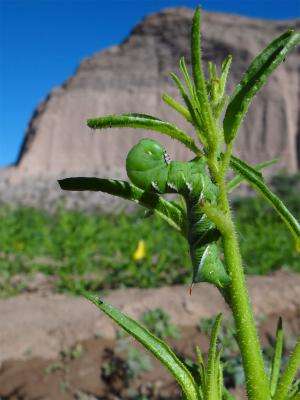December 31, 2013 report
Tobacco hornworm found to use nicotine to create 'defensive halitosis'

(Phys.org) —A team of researchers at the Max Planck Institute in Germany has found that a species of hornworm uses nicotine it gets from eating tobacco plants, as a means of defense. In their paper published in Proceedings of the National Academy of Sciences, the team describes how they found changes in defensiveness in hornworms when fed genetically altered (low-nicotine) tobacco plants.
The tobacco hornworm is actually a caterpillar—prior to turning into a butterfly, it lives on and eats tobacco leaves—an activity that would kill most other organisms due to the nicotine in the plants. But the tobacco hornworm has evolved in such a way as to ward off the toxic properties of the chemical and has even turned it to its advantage, apparently. In this new study, the researchers in Germany wanted to know what sort of mechanism was at work that allowed the hornworm to survive eating such a poisonous plant.
To find out, the team altered the genetic makeup of a certain strain of tobacco and planted it in a controlled part of the desert in Utah—home of the tobacco hornworm. The genetically altered tobacco grew with drastically reduced amounts of nicotine. Careful observation revealed that the hornworms that ate it suddenly became defenseless against wolf spiders.
That led the researchers to take a closer look at a protein called CYP6B46. Normally it's used by animals or insects to detoxify plant material. Prior to the new study, scientists assumed that hornworms were using it in the same way. But that wouldn't explain the change in behavior of the wolf spiders.
Closer examination showed that with tobacco hornworms, CYP6B46 is used to move some of the nicotine from the plants it eats into the bloodstream—from there it is routed to a part of its skin that has vent holes. By pushing the nicotine through the vent holes into the air around them, the hornworms have created a pesticide fog of sorts, preventing wolf spiders (and likely other predators) from eating them.
The researchers note that the nicotine cloud doesn't stop all predators—antlions and big-eyed bugs, for example, still eat them with no apparent ill effects. The researchers don't know why such predators survive the toxic meal though, which means of course, that more research will have to be done.
More information: Natural history-driven, plant-mediated RNAi-based study reveals CYP6B46's role in a nicotine-mediated antipredator herbivore defense, PNAS, DOI: 10.1073/pnas.1314848111
Abstract
Manduca sexta (Ms) larvae are known to efficiently excrete ingested nicotine when feeding on their nicotine-producing native hostplant, Nicotiana attenuata. Here we describe how ingested nicotine is co-opted for larval defense by a unique mechanism. Plant-mediated RNAi was used to silence a midgut-expressed, nicotine-induced cytochrome P450 6B46 (CYP6B46) in larvae consuming transgenic N. attenuata plants producing MsCYP6B46 dsRNA. These and transgenic nicotine-deficient plants were planted into native habitats to study the phenotypes of larvae feeding on these plants and the behavior of their predators. The attack-behavior of a native wolf spider (Camptocosa parallela), a major nocturnal predator, provided the key to understanding MsCYP6B46's function: spiders clearly preferred CYP6B46-silenced larvae, just as they had preferred larvae fed nicotine-deficient plants. MsCYP6B46 redirects a small amount (0.65%) of ingested nicotine from the midgut into hemolymph, from which nicotine is exhaled through the spiracles as an antispider signal. CYP6B46-silenced larvae were more susceptible to spider-attack because they exhaled less nicotine because of lower hemolymph nicotine concentrations. CYP6B46-silenced larvae were impaired in distributing ingested nicotine from midgut to hemolymph, but not in the clearing of hemolymph nicotine or in the exhalation of nicotine from hemolymph. MsCYP6B46 could be a component of a previously hypothesized pump that converts nicotine to a short-lived, transportable, metabolite. Other predators, big-eyed bugs, and antlion larvae were insensitive to this defense. Thus, chemical defenses, too toxic to sequester, can be repurposed for defensive functions through respiration as a form of defensive halitosis, and predators can assist the functional elucidation of herbivore genes.
Journal information: Proceedings of the National Academy of Sciences
© 2013 Phys.org















